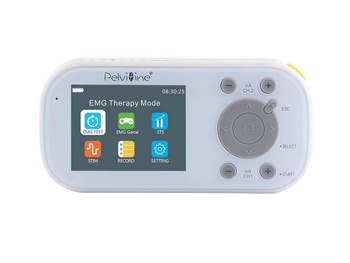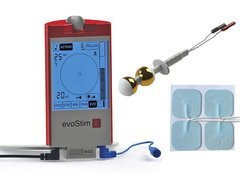Electrostimulators with EMG biofeedback
( number of products: 2 )Kegel biofeedback combined with electrostimulation is an innovative therapeutic method that improves the strength and control of pelvic floor muscles. Biofeedback allows you to track your Kegel muscles and learn how to activate and relax them properly. Electrostimulation, on the other hand, delivers electrical impulses to the muscles, helping to activate and strengthen them. Combined, these two techniques can be an effective treatment for various pelvic floor conditions, such as urinary incontinence, genital prolapse, or even erectile dysfunction in men.
Electrostimulators with EMG Biofeedback – Precision Training for Pelvic Floor Rehabilitation
Electrostimulators with EMG biofeedback represent an advanced form of pelvic floor therapy that combines electrical muscle stimulation with real-time feedback on muscle activation. These devices not only help strengthen and reactivate weakened Kegel muscles, but also teach the user how to consciously control them — which is essential for long-term pelvic health. EMG biofeedback provides visible feedback on muscle tension and relaxation, making it easier to identify correct contractions and maintain proper training technique.
In this category at PelviCare, we present high-quality electrostimulators with biofeedback designed for both home use and professional physiotherapy environments. Each device is selected to support effective pelvic rehabilitation based on the latest clinical standards.
What Is EMG Biofeedback in Pelvic Floor Therapy?
Biofeedback refers to technology that measures the electrical activity of the pelvic floor muscles and displays it in real time, usually on a device screen or mobile app. EMG (electromyography) sensors detect how strongly the muscles contract and relax, allowing the user to visually monitor their performance.
Why is this important?
Many individuals struggle to correctly identify and contract the pelvic floor muscles. Without awareness and proper technique, traditional Kegel exercises may be ineffective or even increase tension if done incorrectly. EMG biofeedback ensures that the user learns how to:
-
Contract the right muscles (not the glutes, abdomen, or thighs),
-
Maintain a balanced rhythm of contraction and relaxation,
-
Track progress and evaluate improvement over time.
This makes biofeedback-assisted training one of the most precise and effective approaches in pelvic rehabilitation.
How Do Electrostimulators with Biofeedback Work?
These devices combine two core functions:
1. Electrostimulation (EMS)
Gentle electrical impulses trigger pelvic floor contractions, strengthening muscle fibers and supporting coordination.
2. EMG Biofeedback Monitoring
The device measures the muscle’s electrical response during contraction and displays it through:
-
Graphs or performance levels,
-
Indicators showing strength of contraction,
-
Guided training programs or visual games (depending on model).
The user gains immediate insight into their muscle activity, helping them understand if they are engaging the pelvic floor correctly and effectively.
When Are Electrostimulators with EMG Biofeedback Used?
Pelvic Floor Weakness and Kegel Muscle Training
Biofeedback is ideal when voluntary contraction of pelvic muscles is difficult or inconsistent. It helps build awareness and muscle memory.
Urinary Incontinence (Stress, Urge, and Mixed)
Devices support controlling bladder function by strengthening the muscles responsible for continence.
Postpartum Recovery
After childbirth, the ability to consciously contract pelvic muscles may be reduced. EMG training helps restore neuromuscular control safely and progressively.
Pelvic Organ Prolapse (Mild to Moderate)
While not a cure, pelvic floor strengthening supports internal organ stability and reduces discomfort.
Sexual Health and Sensation
Improved pelvic control contributes to heightened intimate sensation, comfort, and confidence.
Hypertonic Pelvic Floor (Overactive Muscles)
Some programs include relaxation training — teaching the user to release tension and reduce pelvic pain.
Benefits of Pelvic Floor Electrostimulators with Biofeedback
-
Corrects muscle activation technique
-
Strengthens pelvic floor safely and progressively
-
Improves bladder control and reduces leakage
-
Builds awareness and neuromuscular coordination
-
Supports faster and more predictable rehabilitation progress
-
Provides measurable results and progress tracking
-
Can be used at home or in professional therapy
This combination of muscle training and feedback helps users feel more in control of their pelvic health and recovery.
Who Can Benefit from EMG Biofeedback-Based Pelvic Therapy?
This form of therapy is recommended for:
-
Women after childbirth
-
Individuals experiencing urinary incontinence
-
Women during menopause and hormonal transitions
-
People with difficulty engaging pelvic muscles voluntarily
-
Individuals undergoing pelvic physiotherapy
-
Users with chronic pelvic tension (for relaxation biofeedback)
-
Those seeking structured, measurable pelvic rehabilitation
Before beginning therapy, we recommend consultation with a pelvic physiotherapist, especially if symptoms are complex or longstanding.
Types of Electrostimulators with Biofeedback
Home Use Electrostimulators
Designed to be intuitive and adaptable, often featuring:
-
Mobile app or screen display
-
Guided training programs
-
Step-by-step progression
These devices allow users to train comfortably in their own space while still benefiting from professional-level guidance.
Professional Physiotherapy EMG Systems
Used in clinical settings, offering:
-
Advanced diagnostic tools
-
Customizable programs
-
Detailed patient progress reports
They are ideal for therapists designing individualized pelvic therapy plans.
What to Consider When Choosing a Biofeedback Electrostimulator
-
Ease of use and interface clarity (especially for home therapy)
-
Available stimulation and training programs
-
Comfort and design of vaginal/anal probes
-
Data tracking and progress visualization
-
Compatibility with mobile apps or external screens
-
Clinically validated programs and device certifications
Our product listings provide all necessary details to help choose the correct model.
Safe Use and Best Practices
To ensure safe and effective therapy:
-
Begin with low stimulation levels and adjust gradually.
-
Practice in a quiet, comfortable environment to focus on muscle awareness.
-
Ensure the pelvic floor is relaxed between contractions — recovery is key.
-
Maintain consistent practice (e.g., daily or several times per week).
-
Clean probes and equipment thoroughly after each session.
Those with pacemakers, active pelvic infections, or pregnancy should consult a specialist before use.
Electrostimulators with EMG Biofeedback Available at PelviCare
In this category you will find:
-
Home pelvic floor EMG biofeedback stimulators
-
Professional EMG pelvic therapy systems
-
Vaginal and anal EMG probes
-
Replaceable electrodes and accessories
-
Biofeedback-based pelvic exercise support tools
All products are selected based on clinical reliability, user comfort, and therapeutic effectiveness.
Train With Awareness. Strengthen With Purpose. Restore With Confidence.
Pelvic floor health is essential for comfort, mobility, confidence, and intimate well-being. Electrostimulators with EMG biofeedback empower users to actively participate in their recovery, making pelvic training more precise, more effective, and more meaningful.
Whether you are just beginning your rehabilitation journey or enhancing ongoing therapy, PelviCare is here to support you with carefully chosen devices that promote measurable progress and lasting pelvic health.


